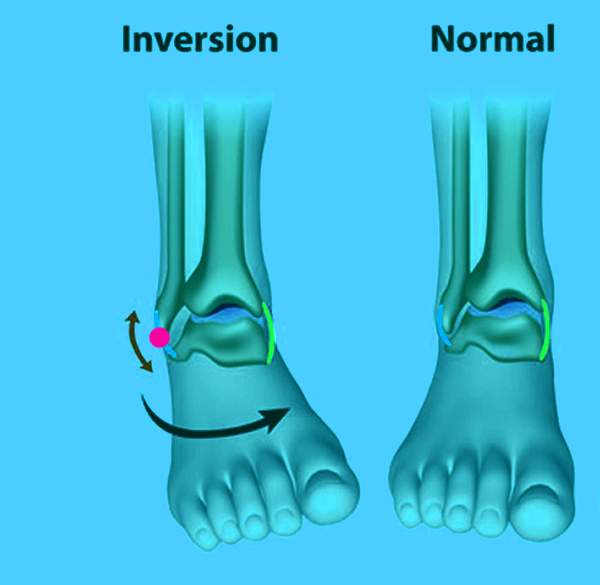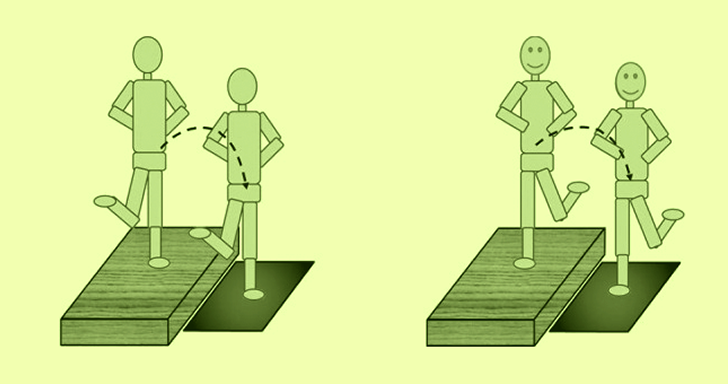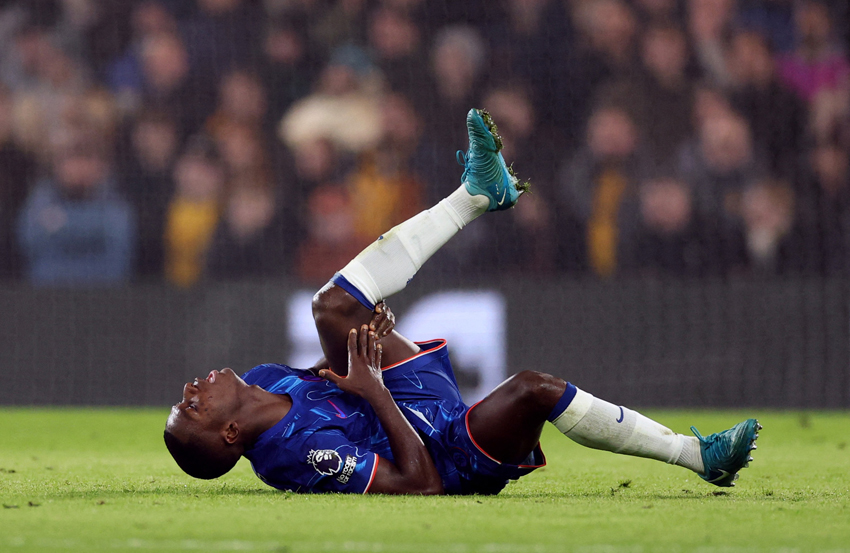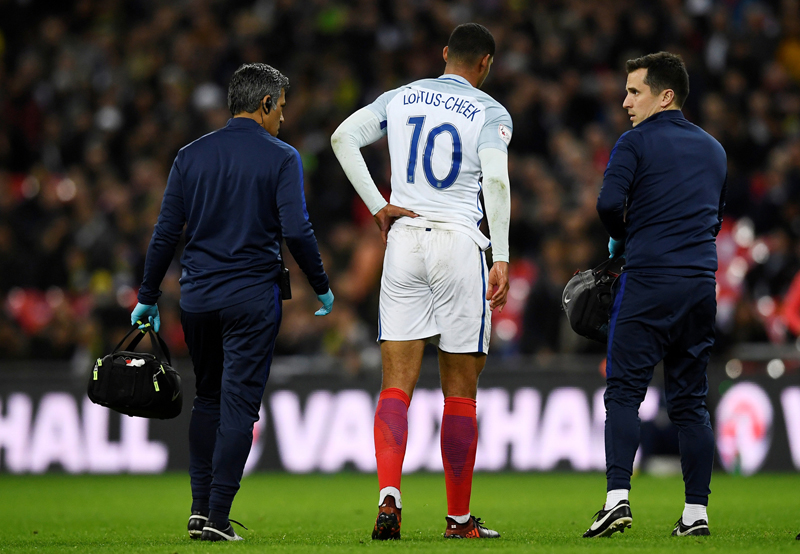You are viewing 1 of your 1 free articles. For unlimited access take a risk-free trial
Ankle injury rehab: should you jump for joy?
Can a plyometrics training program help athletes overcome chronic ankle injuries and prevent future injuries? SPB looks at the recent evidence and comes up with practical recommendations
Ankle sprains are one of the most common musculoskeletal injuries to sideline sportsmen and women. Indeed, some studies suggesting that up to 45% of all sports related injuries may be related to ankle injuries brought about by poor ankle strength and stability (ankle instability)(1). In particular, when the structural integrity of the crucially important lateral ligaments of the ankle (for example, the anterior talo-fibular ligament whose function is to stabilize the ankle joint - see figure 1) is compromised, an ankle injury is much more likely to occur. Once injured, the ankle is more prone to re-injury, and in the longer term, chronic ankle instability becomes a real risk for athletes.
Figure 1: Locations of stabilizing ligaments in the lateral ankle
Ankle injury causes
Why do ankle injuries occur in athletes? The most common single factor that causes an ankle sprain is a single-limb landing on an uneven surface(2). In these circumstances, a rapid and combined motion of ankle plantar flexion (toes pointing away from the shin) and ankle inversion (going over on the outside of the ankle, stretching the lateral ankle ligaments – see figure 2) can lead to excessive lateral motion, resulting in ankle sprain.
Figure 2: Ankle inversion (in lateral ankle sprain)
Ankle inversion describes the motion where the foot tips ‘outwards’ under load, stress and potentially injuring the lateral ankle ligaments (location of red dot) whose job it is to stabilize the ankle joint.
Another possible factor in determining the likelihood of lateral ankle sprain is proprioception, which is an important element of the neuromuscular control. Proprioception can be described as the ability of the body to maintain awareness of the location of the limbs in 3-dminsional space during movement. Without sufficient proprioception, an athlete may be unable to detect the speed and magnitude of perturbation in a timely fashion, and therefore unable react with proper and sufficient muscle activation and joint motion. Uneven terrain under foot can further exacerbate this problem.
Unfortunately for an ankle-injured athlete, research clearly shows that once an injury has occurred, re-injury is very likely, leading to chronic ankle instability. This is because injury/damage to the lateral ligaments and joint capsule (the fibrous membrane surrounding the joint) very often impairs the ability of these structures to provide optimum mechanical restraint following injury(3-10). Combined with any deficits in propioception, this results in a high re-injury rate. Indeed, studies have shown that 73% of individuals who sprain their ankles are likely to experience recurrent ankle injuries(11).
When recurrent ankle injuries over a period of time occur in athletes, it is often referred to as ‘functional ankle instability’. Functional ankle instability (abbreviated FAI) is defined as subjective ankle instability, giving way, and repetitive ankle sprain(12. Given the implications (ie risk of constant re-injury) of FAI in athletes, ways of combating and minimizing/eliminating it have been investigated extensively by physiotherapists and sports scientists.
Balance and FAI therapy
One popular method to combat FAI is the use of balance training, which research shows is an effective way of reducing episodes of inversion in individuals with chronic or functional ankle instability and improving joint position error(13). In recent studies, balance-training interventions of both three and six weeks were shown to not only reduce ankle joint position error but also to improve postural stability. For a more in-depth discussion of balance training for ankle instability, readers are directed to this article in our sister publication Sports Injury Bulletin’.
Unfortunately, while balance training does seem to reduce ankle joint position error and increase stability in a standing position, the effects of balance training on the muscle activation strategy in individuals with FAI are less clear. In other words, balance training doesn’t seem to help the ability of the ankle muscles to fire optimally in order to stabilize and strengthen the ankle during complex motions such as landing on ueven ground.
For example, research on individuals with FAI who undertook a period of balance/propioception training showed that the electrical activity (EMG) signals of the peroneus longus and brevis and tibialis anterior (shin muscles that also help stabilize the ankle) showed no change during the first 60 milliseconds following a sudden external ankle inversion stimulus(14). Given that optimal muscle activation and recruitment is essential for minimizing the effects of unexpected perturbations in FAI, the results from balance training to improve FAI are somewhat disappointing.
Plyometrics and FAI
Given that athletes with ankle instability frequently demonstrate altered patterns of joint movement and muscular control, the use of plyometrics in FAI rehab has also been considered. Plyometrics exercises are recognized as an effective strategy for ‘neuromuscular training’ because they are able to alter the motor unit recruitment patterns and therefore muscle activity by activating the ‘sensorimotor system’ – ie involving the feedback loop between sensory input and muscle output(15). This in turn increases the excitability of the nerve receptors in the muscles, thereby improving the reactivity of the neuromuscular system – for example, the ankle muscle firing patterns when the foot lands on some unexpectedly uneven terrain. Moreover, studies have shown that plyometrics exercise reduces the risk of injury by increasing the functional stability of the lower limb joints(16) (and other joints in the body such as the shoulder joint)(17).
The theory that plyometrics could help ankle stability and help overcome ankle instability looks good; the problem however is that there is little data in the literature on the feasibility and effects of plyometrics training for the neuromuscular rehabilitation of athletes with FAI. One study investigated a combination of plyometrics and balance training in healthy (ie uninjured) adolescents aged 12–15 years old(18). It found that a combination of balance and plyometrics resulted in superior leg stiffness and running performance compared plyometrics training alone. However, a true comparison of plyometrics training with and without added balance training in athletes with FAI has not been carried out to date, so until now, the use of plyometrics in FAI remains theoretical rather than proven benefit.
New research
Fortunately, some very research and comprehensive research on plyometrics for FAI rehab/management provides solid evidence. A 2021 study carried out by Taiwanese researchers, which was published in the International Journal of Environmental Research and Public Health investigated the effects of plyometrics (and balance) training on neuromuscular control of recreational athletes with FAI(19).
In this study, thirty college athletes aged 18 and 30 years, all with diagnosed FAI, were recruited from local campuses at initial recruitment. To qualify for inclusion, the athletes had to meet the following criteria:
- Participating regularly (at least 1–2 hours per session, 2–3 sessions per week) in sports activities (eg basketball, rugby, soccer, and volleyball).
- Had experienced at least one prior ankle inversion sprain that resulted in swelling, pain, and dysfunction over the past 12 months.
- Had experienced multiple ankle sprains or sensations of ankle ‘giving way’ events over the past 12 months.
- Scored less than 24 on the Cumberland Ankle Instability Tool (CAIT) questionnaire (a validated assessment tool for degree of ankle instability)(20).
- Tested negative in anterior drawer and talar tilt tests (ie this meant the athletes did NOT have tears of their lateral ankle ligaments but were suffering from general ankle instability).
These athletes were divided into three groups:
- Plyometrics only training
- Integrated balance and plyometrics training
- Control group (no specific training)
Each training program lasted for six weeks and all athletes had to train at least twice per week (although they were encouraged to complete three sessions per week). The content of plyometrics training started with a simple squat jump and progressed to more challenging jump and hops, while the integrated balance training/plyometrics training group involved jumps and a balanced squat or balanced lunge every week. The complete training program can be found in table 1 below and also viewed in the paper by Huang et al - viewed here(21).
Table 1: Details of the plyometrics/plyometrics + balance training programs(21)
|
Weeks |
Plyometrics Training |
Repetitions |
Sets |
Integrated: Plyometrics +Balance Training |
Repetitions or Time |
Sets |
|
1 & 2 |
Squat jumps |
10 |
2 |
Squat jumps |
10 |
2 |
|
Ankle jumps |
10 |
2 |
Balanced squat |
10 |
2 |
|
|
Jump for distance |
10 |
2 |
Balanced dribble |
20 |
5 |
|
|
Forward zigzag jumps |
10 |
3 |
Forward zigzag jumps |
10 |
3 |
|
|
Lateral sawtooth jumps |
10 |
3 |
Lateral sawtooth jumps |
10 |
3 |
|
|
Jump up on step |
8 |
2 |
Jump up on step |
8 |
2 |
|
|
3 & 4 |
Split-squat jumps (right/left) |
10 |
2 |
Split-squat jumps (right/left) |
10 |
2 |
|
Hop for distance (right/left) |
10 |
2 |
Balance lunge (1 disc, right/left) |
10 |
2 |
|
|
Forward zigzag hops (right/left) |
10 |
3 |
Forward zigzag hops (right/left) |
10 |
3 |
|
|
Lateral sawtooth hops (right/left) |
10 |
3 |
Balanced single-leg standing (right/left) |
10 s |
5 |
|
|
Tuck jump |
10 |
2 |
Tuck jump |
10 |
2 |
|
|
Diagonal hop |
8 |
2 |
Balanced catch ball |
8 |
2 |
|
|
Jump up on step |
10 |
2 |
Jump up on step |
10 |
2 |
|
|
5 & 6 |
Cycled single-leg squat jumps |
10 |
2 |
Cycled single-legged squat jumps |
10 |
2 |
|
Hop on target (right/left) |
12 |
2 |
Balance lunge (2 discs, right/left) |
12 |
2 |
|
|
Jump for distance and height |
10 |
2 |
Jump for distance and high |
10 |
2 |
|
|
Forward zigzag hops (right/left) |
10 |
3 |
Forward zigzag hops (right/left) |
10 |
3 |
|
|
Lateral sawtooth hops (right/left) |
10 |
3 |
Balanced, single-legged standing dribble (right/left) |
20 |
5 |
|
|
Tuck jump |
10 |
2 |
Tuck jump |
10 |
2 |
|
|
Agility ladder |
3 |
1 |
Agility ladder |
3 |
1 |
|
|
Jump up on step |
10 |
2 |
Jump up on step |
10 |
2 |
NB: Each training section consisted of 3 minutes of general stretching exercise and 7 minutes of aerobic exercise (800m run) as a warm-up. Between exercises in each training session, a 2-minute rest was allowed. For the cool-down phase, participants performed general stretching again for 5 minutes.
The before and after testing consisted of joint position sense testing, where the ankle joint proprioception of the participants was evaluated, and a dynamic technique known as ‘single-leg medial drop-landing testing’ (see figure 3). Joint angles during testing were also assessedThis particular drop-landing task was chosen because it causes the greatest ankle inversion/eversion angles, which are much more challenging for athletes with FAI, and it also has excellent reliability(22).
Figure : Single leg medial drop-landing test*
The platform height in this test was set at 16cms. *adapted from Huang et al - J Athl Train. 2014 Mar-Apr; 49(2): 163–172
For each trial, the participants were asked to stand on one leg with both hands on the waist for three seconds as a preparatory movement. In response to an auditory cue, the participants then hopped down onto a force plate; regained their stability as quickly as possible and kept their body erect and the head looking forward. Once the participants reached a balance status, the participants were requested to maintain the single-leg stance for another five seconds. A failure was defined as repetitive hopping on the force plate, the unloaded foot contacting the ground, or moving the hands away from the waist.
The findings
The key findings after six weeks of training (compared to the control group) were as follows:
- Both the plyometrics-only and the plyometrics plus balance training groups had better patterns of foot movements when landing. The plyometrics-only group reduced average plantar flexion angles from 3.79° to 2.20° while the balance plus plyometrics group reduced from 4.10° to 2.94°.
- The plyometrics plus balance group showed a lower absolute error in ankle inversion angles (pre 2.24°, post 1.48° - ie less ‘tipping over movement’), and an increased electrical activity of the foot muscles (plantar flexors) before landing.
- The plyometrics-only group (but NOT the balance + plyometrics group) exhibited a higher electrical activity of the tibialis anterior before and after landing and a shorter adjusting time of the plantar flexor muscles following landing (reduced from 2.85 seconds to 1.87 seconds). In plain English, the motor firing patterns of the shin and ankle muscles were enhanced by plyometrics training, enabling them to adjust and stabilize the ankle much more quickly and effectively during single-leg landing.
What do these findings mean for coaches and athletes?
The findings in athletes with FAI as outlined above – ie that there was an improved inversion joint position sense for the integrated (plyometrics plus balance) training group - are consistent with the results of many previous studies(23). However, and very importantly, what this research shows is that plyometrics exercise in itself is beneficial in improving the proprioception of individuals with ankle instability. Indeed, as the research above shows, isolated plyometrics training leads to a more rapid stabilization in the ankle plantar flexors during a medial single-leg drop-landing task.
This finding is certainly consistent with our understanding of the theory behind plyometrics; plyometrics training involves repetitive ballistic motions which cause the mechanoreceptors within or around the targeted joint to undergo continual stimulation and therefore improve the sensitivity of the neuromuscular receptors to the joint position(24). This almost certainly explains why the plyometrics-trained athletes experienced greater electrical activity in tibialis anterior (frontal shin muscle) before and after landing.
For coaches and athletes seeking to improve ankle stability and resilience to injury, we can conclude that plyometrics should be considered an essential component of training but also that both balance and plyometrics training can play a role in a strength and conditioning program. In the study above, the researchers recommended that a selection of both balance and plyometrics training exercises should be selected (based on the individual needs of the athlete), and incorporated into his/her training and rehabilitation program. This strategy is likely to provide the very best outcomes in FAI. As mentioned above, table 1 above provides a repertoire of plyometrics exercises that can be combined with balance training for maximum benefits, and should make a great starting point for any athlete suffering from FAI!
References
- Conscious Cogn 2003; 12: 609-619
- Foot Ankle 1990; 11: 41-44
- Aust J Physiother 2007; 53: 193-198
- J Athl Train 2012; 47: 444-456
- J Athl Train 1997; 32: 221-225
- J Athl Train 2002; 37:487-493
- J Orthop Sports Phys Ther 2003; 33:166-173
- J Orthop Sports Phys Ther 2013; 43: A1-40
- Am J Sports Med 2005; 33: 1174-1182
- J Bone Joint Surg Br 1965; 47: 678-685
- Br J Sports Med 1994; 28: 112-116
- Clin Sports Med. 2008 Jul; 27(3):353-70, vii
- J. Back Musculoskelet.Rehabil. 2020, 34, 95–101
- Med Sci Sports Exerc. 2001 Dec; 33(12):1991-8
- J Strength Cond Res. 2008 May; 22(3):861-8
- J Can Chiropr Assoc. 2019 Dec; 63(3):144-153
- Sports Health. 2015 Jan; 7(1):75-9
- J Strength Cond Res. 2014 Feb; 28(2):401-12
- Int J Environ Res Public Health. 2021 May; 18(10): 5269
- Arch Phys Med Rehabil. 2006 Sep; 87(9):1235-41
- J Athl Train. 2014 Mar-Apr; 49(2): 163–172
- Eur J Phys Rehabil Med. 2008 Dec; 44(4):407-15
- J. Foot Ankle Res. 2014;7(Suppl. 1):A37
- J Shoulder Elbow Surg. 2002 Nov-Dec; 11(6):579-86
Newsletter Sign Up
Testimonials
Dr. Alexandra Fandetti-Robin, Back & Body Chiropractic
Elspeth Cowell MSCh DpodM SRCh HCPC reg
William Hunter, Nuffield Health
Newsletter Sign Up
Coaches Testimonials
Dr. Alexandra Fandetti-Robin, Back & Body Chiropractic
Elspeth Cowell MSCh DpodM SRCh HCPC reg
William Hunter, Nuffield Health
Keep up with latest sports science research and apply it to maximize performance
Today you have the chance to join a group of athletes, and sports coaches/trainers who all have something special in common...
They use the latest research to improve performance for themselves and their clients - both athletes and sports teams - with help from global specialists in the fields of sports science, sports medicine and sports psychology.
They do this by reading Sports Performance Bulletin, an easy-to-digest but serious-minded journal dedicated to high performance sports. SPB offers a wealth of information and insight into the latest research, in an easily-accessible and understood format, along with a wealth of practical recommendations.
*includes 3 coaching manuals
Get Inspired
All the latest techniques and approaches
Sports Performance Bulletin helps dedicated endurance athletes improve their performance. Sense-checking the latest sports science research, and sourcing evidence and case studies to support findings, Sports Performance Bulletin turns proven insights into easily digestible practical advice. Supporting athletes, coaches and professionals who wish to ensure their guidance and programmes are kept right up to date and based on credible science.













